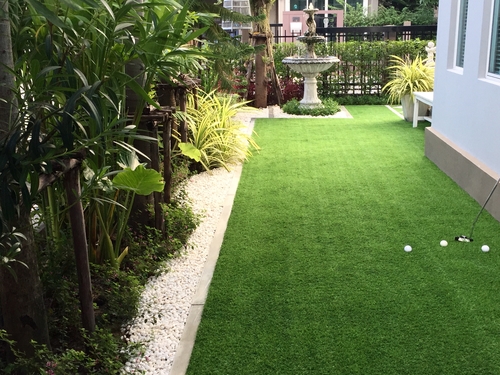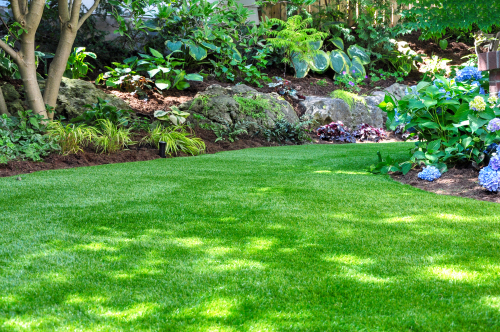Artificial Grass: How Do I Prepare for Installation?
May 28
Trying to prepare to install artificial grass may seem easy at first, but then the questions start crawling into your mind, making you doubt your every decision – “What’s artificial grass made of?”; “Is artificial grass good for my pets?”; “Will artificial turf start smelling bad soon?”…
Oh, the horror, oh the worries… You can always make it easier on yourself and look for a trusted company in San Diego for artificial turf installation, and be worry-free in a matter of minutes. But, in case you’re still set on going at it alone let’s see if we can help ease your troubles.
 Before you can get cracking you need to do the following:
Before you can get cracking you need to do the following:
 If it’s professionals you want, it’s professionals you’ll get. Pacific Dreamscapes should be your go-to company for everything relating to artificial turf. We’ll have you smiling with a fresh, green artificial lawn in no time. You probably need a fresh lawn now more than ever, when it’s difficult to get out and visit Balboa Park. We’re here for all the landscaping you need. Contact us and let’s see if we can make something work.
If it’s professionals you want, it’s professionals you’ll get. Pacific Dreamscapes should be your go-to company for everything relating to artificial turf. We’ll have you smiling with a fresh, green artificial lawn in no time. You probably need a fresh lawn now more than ever, when it’s difficult to get out and visit Balboa Park. We’re here for all the landscaping you need. Contact us and let’s see if we can make something work.
How to install artificial turf?
The process of installing artificial turf is not that complicated that you can’t do it on your own – you can. Although this is true, we always advise seeking the help of qualified professionals as they use the best tools available and employ advanced techniques to install your turf. Chances are, you’ve no idea just what steps you should take when installing artificial turf, nor how you should prepare your yard for the installation. What do you say to a detailed guide? This is how professionals install artificial turf:Pre-installation
 Before you can get cracking you need to do the following:
Before you can get cracking you need to do the following:
- Remove any existing materials, be they grass, weeds, soil, or something else. Also, make sure to remove any wiring, piping, etc.
- Cap or relocate any potentially existing sprinklers.
- Optionally, you can install a bender board.
Preparing the base
Next, it’s time to prepare your base. There are two options when it comes to base preparation:- Using a special mixture that will serve as a base for your artificial turf. This mixture is usually made of sand and gravel.
- Preparing the ground for installing artificial turf. We’ll explain this in greater detail later on.
Compacting
No matter whether you’ve opted to use a special mixture as your base, or to prepare the ground for artificial turf, you need to compact the base in order to be able to cover the base properly with artificial turf.Installing and trimming
Once the base is set, you can go on to actually working with artificial turf in two very specific ways:- You can now place the artificial turf over the prepared and compacted base.
- Then, you have to trim the turf. Make sure to overcut the artificial turf by a single inch. This inch should go over the edges, and it serves as a vital part for the next step, which is
Turf-tucking
Next, you should take that extra inch and place it, or, hide it, if you want, underneath or against any hard edges in your yard. This will give your artificial turf a clean, plush look.Applying filler
Now, for this next step you’re going to need a power brush. What you do is:- You take the power brush, and you brush the artificial turf against the grain. This will prepare the turf for the filler.
- Next, you take the filler of choice, either durafill sand or infill, and you thoroughly spread the granules all over your artificial turf. Make sure to do it evenly too.
Finishing touches
You’re almost done, almost. All that’s left is to finely groom your artificial turf by brushing it, this time, more gently. Also, try to remove any debris that might have been left behind during the previous steps. And voila, your artificial turf is ready for some barefoot action!How do you prepare the ground for artificial grass?
As we said, it’s now time to take a closer look, a deeper dive, to do an in-depth analysis on preparing your ground for a layer of artificial grass. Nothing to it, really, especially if you choose to follow our quick-but-detailed guide:- Removal – Before preparing the ground, you have to remove any existing grass. You can do this either by hand, or you can choose the quicker route of using a weedkiller.
- Watering – Then, lightly water the soil to make it easier to work with.
- Turning over – After watering, leave the soil to rest for some 10 to 15 minutes before taking a spade and turning it over five to ten centimeters in depth. No deeper, this is enough for good stability of artificial grass.
- Leveling – After turning your ground over, you should level it out, make sure there are no clods, and remove any roots that may have persisted.
- Evening – The penultimate step is making sure your ground is all nice and even all the way across. This means filling in the holes, flattening bumps, and trying to create a surface that has gentle contours.
- Compacting – Finally, take a whacker plate or a garden roller and make sure your ground is nice and firm. And that’s it – your ground is ready for artificial turf.
What do you put under artificial grass?
We feel like we’ve already explained the two types of bases you can choose to place underneath your artificial grass. Whichever one you choose you’ll be OK, especially if you nicely even out the surface and make it as flat as possible. However, we have to mention two additional items you should consider placing beneath your artificial turf, as they can greatly increase the lifespan of your artificial turf:- Underlay – This provides an extra dose of comfort for when you’re stepping onto your artificial grass, but it also provides protection for your artificial grass from the harder surface that sits underneath it.
- Weed membrane – You should also consider placing a weed suppressant membrane underneath your artificial grass, as it will prevent any weeds to make their way through to your artificial turf.
“I’d rather a professional handle my artificial turf installation in San Diego!”
 If it’s professionals you want, it’s professionals you’ll get. Pacific Dreamscapes should be your go-to company for everything relating to artificial turf. We’ll have you smiling with a fresh, green artificial lawn in no time. You probably need a fresh lawn now more than ever, when it’s difficult to get out and visit Balboa Park. We’re here for all the landscaping you need. Contact us and let’s see if we can make something work.
If it’s professionals you want, it’s professionals you’ll get. Pacific Dreamscapes should be your go-to company for everything relating to artificial turf. We’ll have you smiling with a fresh, green artificial lawn in no time. You probably need a fresh lawn now more than ever, when it’s difficult to get out and visit Balboa Park. We’re here for all the landscaping you need. Contact us and let’s see if we can make something work. 